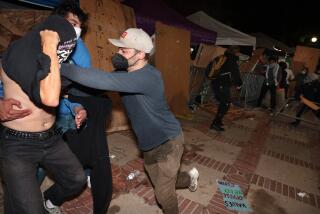Fido still needs his leash, but he won’t have to read about it in Hermosa Beach
Oh where, oh where have the leash law signs gone on the greenbelt in Hermosa Beach?
Since November, when the city voted to stop allowing dogs to romp freely on the verdant strip, temporary cardboard signs have been posted warning pet owners that leashes are now required.
But one by one, the “Be A Good Neighbor” signs have been “ripped and shredded by vandals,” Mayor Roger Creighton said. And this week, the City Council voted 4 to 1 not to replace them with permanent notices.
City Manager Kevin Northcraft had noted that there are leash law signs all along the greenbelt in Manhattan Beach, and said the lack of such signs in Hermosa Beach’s share of the strip might confuse pet owners. But Councilwoman Kathleen Midstokke, who led the no-sign vote, said the signs are “visual pollution, and our city, with all its parking enforcement, has enough signs around already.”
Midstokke added that she had been lobbied by pet owners who had vigorously opposed having a leash law on the greenbelt and who felt that the installation of permanent signs was just the city’s way of rubbing their noses in their defeat. The only vote in favor of the permanent signs came from Councilman Chuck Sheldon, who was part of the council majority that put a pro-leash-law measure on the ballot.
“They (the pet owners) felt it was unnecessary and insulting to them,” Midstokke said, “and I did feel some political undertones from the supporters of the leash law.”
Midstokke was elected to the council in November along with two other candidates endorsed by pet owners.
Street gangs are leaving their imprint everywhere.
In some neighborhoods, residents walk in fear of drive-by shootings, robberies, gang fights and other violent acts. Wearing the wrong color can be an invitation to death or injury.
The influence of the Bloods and Crips, two of the largest gangs, is even affecting everyday decisions by South Bay school boards, Kiwanis Clubs and student councils.
When school officials in Inglewood recently decided to start parent patrols to increase security at Morningside High School, they came up with the idea of giving them identifying T-shirts.
“Parent Aid Corps” was printed on the red T-shirts and they were presented to the school board Wednesday night.
That’s when board member Lois Hill Hale reminded her colleagues that red and blue are affiliated with area gangs and that the T-shirts might put the parents in jeopardy.
Katrina Hamilton, a junior at Morningside, agreed.
“The red might serve to provoke people,” she said in an interview. “Even though red is our school color, people still consider it the color of the Bloods.”
Johnnie Thomas, the school district’s police chief, thought the red shirts were a bad idea, too.
“It’s a gang-infested area,” he said of the neighborhood surrounding Morningside. “The Murder Street Crips are over there. The Center Park Boys and Crenshaw Mafia are there. Some of the Lennox gang members are in that area. I wouldn’t wear red or blue anywhere near there.”
The board members decided to reorder the shirts.
Members of the Lomita-Harbor City Kiwanis Club faced a similar flap last month when they donated anti-drug headbands to students at Lomita’s Eshelman Avenue Elementary School.
The problem? They were red, white and blue.
A parent complained about the gang colors, and the Lomita sheriff’s station agreed that the headbands were the wrong hue. Sheepish Kiwanis Club officials later issued neutral white headbands.
Those involved in the color controversies say street gangs have made it necessary to stop and think about even the most benign activities.
In October, Assemblyman Curtis Tucker Jr. (D-Inglewood) promoted an anti-drug program in his district called “Red Ribbon Week.”
The student council at Inglewood High School wanted to participate but they knew better.
They held “Yellow Ribbon Week.”
More to Read
Start your day right
Sign up for Essential California for news, features and recommendations from the L.A. Times and beyond in your inbox six days a week.
You may occasionally receive promotional content from the Los Angeles Times.






